Hibiscus plants add color to your garden every spring and summer. If you want to grow them, you need to know the ideal care tips to keep them healthy in the long run.
6-8 hours of sunlight, regular watering, well-drained loamy soil, and fertilization during summer are the basic requirements of the hibiscus plant. Apart from these, maintaining a temperature around 65-75°F with high humidity and yearly repotting will further help your hibiscus thrive.
It is the right place if you are a beginner at growing Hibiscus plants. This guide will explore the plant’s basic care tips for optimal growth and development.
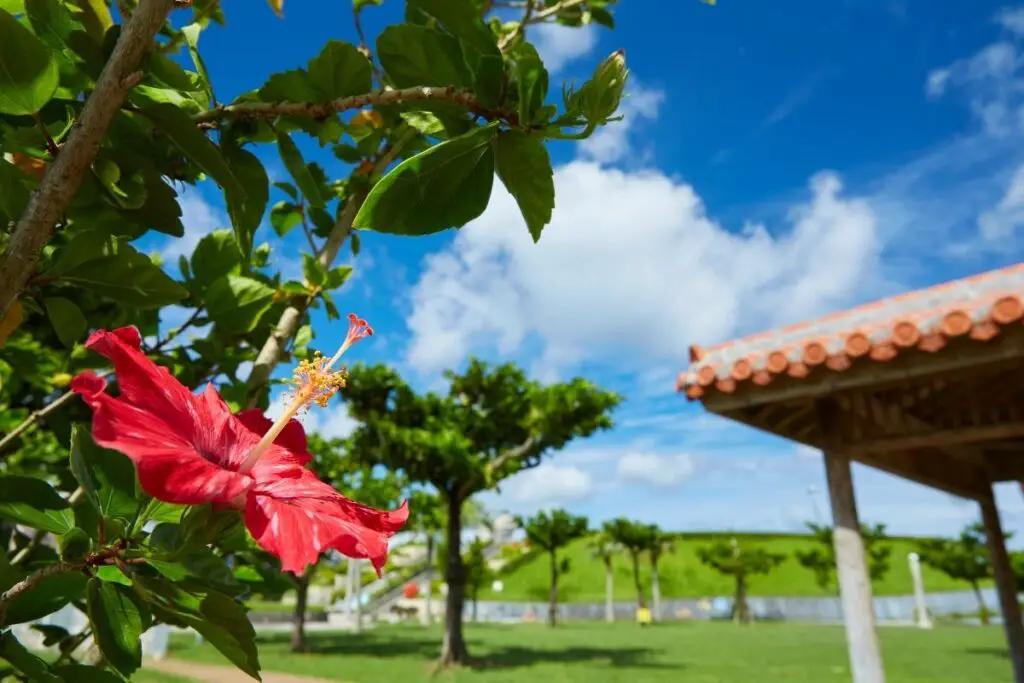
Care Tips For Your Hibiscus
Hibiscus plants are tropical plants.
They are easy to grow and hard to kill. Once you know the care tips rightly, you can easily care for them.
Let’s dive into the care tips.
1. Let Hibiscus have 6 to 8 hours of sunlight.
Hibiscus requires 6-8 hours of sunlight per day.
Hibiscus can stay healthy and green under partial shade, but it cannot use its potential energy to produce flowers.
So, direct sunlight is essential.
If the sunlight is too intense, let Hibiscus have 2-3 hours of direct sunlight in the morning and 6-8 hours of partial sunlight throughout the day.
In the summers, give some shade by fixing shading nets during the afternoon to reduce sunburn risks.
But, don’t block the sunlight because the plant needs PAR light from the direct sun.
It would be better if your garden had a place that can get 6 to 8 hours of sun and some trees at a distance for shade in the afternoon.
Your Hibiscus will stay fine.
Also read: How Much Light Does A Hibiscus Plant Need? (What Kind, How Much & More)
2. Water the Hibiscus regularly.
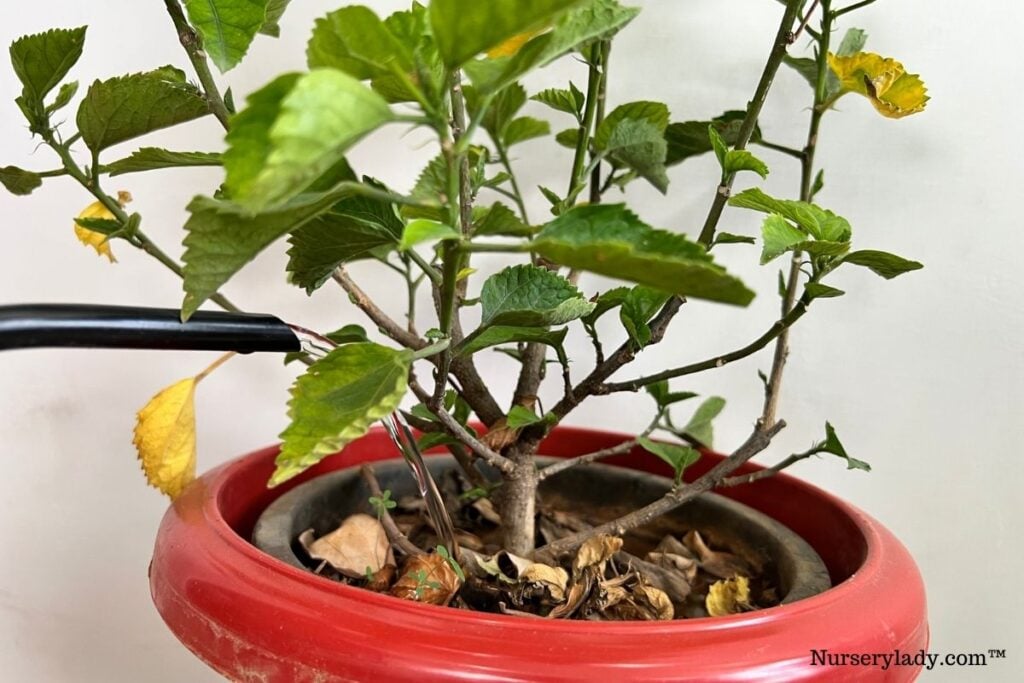
Hibiscus requires watering 4-5 days per week.
Hibiscus needs daily watering in summers because the soil dries faster under the sun.
Sometimes, Hibiscus will need watering 2 times per day if the weather is that much sweltering.
Hibiscus will reduce its growth in the winters and absorb water slowly.
Water it less frequently.
Watering once a week is enough.
Check the soil’s moisture level before watering to understand the watering needs best.
When the top 1-2 inches are dry, the plant is ready to take water.
Use a moisture meter if you cannot understand the moisture with your finger.
Water the plant when the result is between 1 and 3.
Also read: How To Water Hibiscus Plant? (How Much, How Often & More)
Looking for gardening supplies? We have tested 100's of products before recommending them to you guys. Check out our best pick below:
| Image | Gardening Supplies | Best Price? |
|---|---|---|
 Top
Top Top
Top | Raised Garden Bed Kit | Check On Amazon |
 | XLUX Soil Moisture Meter, Plant Water Monitor, Soil Hygrometer Sensor for Gardening, Farming, Indoor and Outdoor Plants, No Batteries Required | No Results |
 Top
Top Top
Top | 82 Pcs Garden Tools Set and Extra Succulent Tools Set | Check On Amazon |
 | Joeys Garden Expandable Garden Hose with 8 Function Hose Nozzle, Lightweight Anti-Kink Flexible Garden Hoses, Extra Strength Fabric with Double Latex Core, (50 FT, Black) | No Results |
 Top
Top Top
Top | Dual Chamber Compost Tumbler | Check On Amazon |
 Top
Top Top
Top | Sunnyglade Plant Stakes | Check On Amazon |
 Top
Top Top
Top | Organic Cold Pressed Neem Seed Oil | Check On Amazon |
 Top
Top Top
Top | Mighty Mint Gallon :-Insect and Pest Control Peppermint Oil | Check On Amazon |
 Top
Top Top
Top | Scotts DiseaseEx Lawn Fungicide | Check On Amazon |
 Top
Top Top
Top | Jacks Classic 20-20-20 All Purpose Fertilizer | Check On Amazon |
 Top
Top Top
Top | 30,000 Seeds Pollinator Attracting Wildflower Mixture | Check On Amazon |
 Top
Top Top
Top | Survival Vegetable Seeds Garden Kit-Over 16,000 Seeds | Check On Amazon |
3. Use well-drained loamy soil for your Hibiscus.

The soil should have a balance between retention and drainage.
The excess water should drain from the soil.
At the same time, it should hold moisture for some time as Hibiscus loves moist soil.
If the soil fails to drain, the plant will experience overwatering issues.
On the contrary, low retention qualities can cause frequent droughts and under fertilization.
The pH level has to be within 6.5 to 6.8.
An incorrect pH level blocks the soil from absorbing other essential nutrients.
Some ideal soil mixes are:
- 2 parts potting soil, 2 parts peat moss, and 1 part vermiculite or perlite
- Composted bark, composted manure, coarse peat, and little vermiculite
- 50% peat, 45% composted bark and 5% perlite
- 2 parts garden soil, 1 part compost, and 1 part sand
If you plant Hibiscus in the ground, first check the soil pH level.
Dig the above few inches of the soil and add ingredients like perlite, sand, and compost to make it ideal for your Hibiscus.
You should also check the water permeability while planting Hibiscus on the ground.
Hibiscus roots are 6 inches deep.
The water needs to penetrate at such depth.
Also read: What Kind Of Soil Does A Hibiscus Plant Like? (+Best Soil Mix)
4. Use the right formulation fertilizer at the right season.

Hibiscus plants are heavy feeders.
They need a fertilizer with average nitrogen, low in phosphorus, and high in potassium.
Choose a fertilizer with an NPK value of 10-4-12 or 17-5-24.
The best time to fertilizer is in spring and summer.
If you use water-soluble or liquid fertilizers, apply them every 2 weeks in the growing season and every 4 weeks in winter.
If you use slow-release, apply it every 3 to 6 months.
It works well for grounded plants.
Please don’t use it in the winter.
For organic fertilizers, you can use wood ash, coffee grounds, Epsom salt, banana peels, eggshells, fish tank water, etc.
Also read: What Is A Good Fertilizer For Hibiscus Plants? (Ideal Ratio+Best Pick)
5. Maintain a warm temperature zone for seamless growth of your Hibiscus.
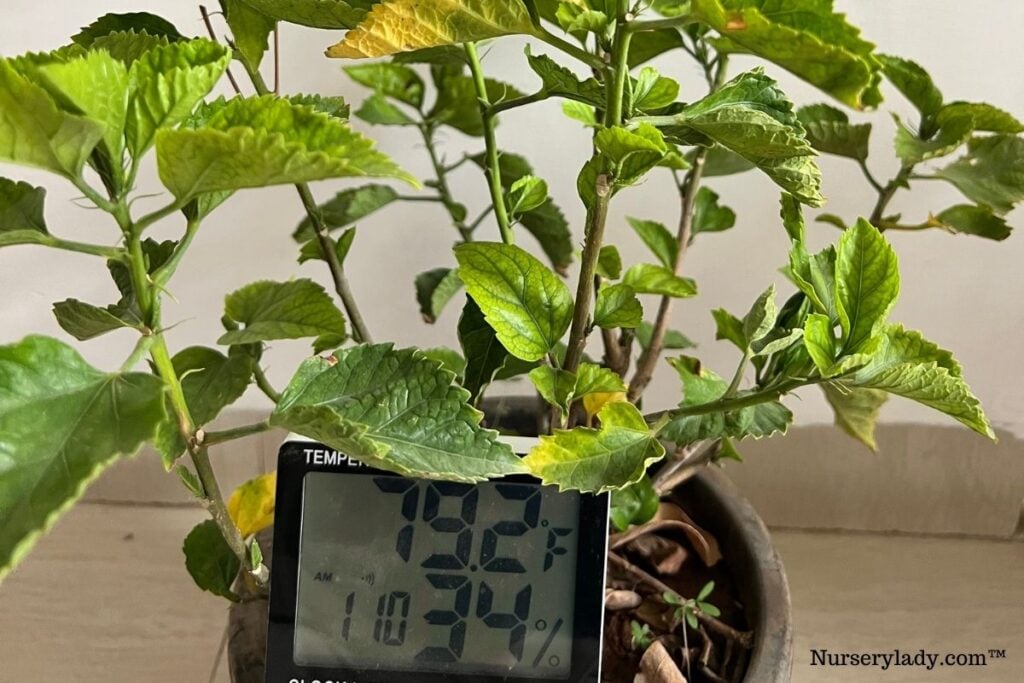
The best temperature for Hibiscus ranges between 65°F and 75°F.
Being native to tropical areas, Hibiscus enjoys warm temperatures.
The minimum tolerance is 55°F, and the maximum is 85-90°F.
Tropical Hibiscus varieties cannot tolerate cold temperatures.
Their minimum temperature tolerance is 32-40°F.
They are native to zones 9 to 12, and the lowest temperature in zone 9 is 32°F.
However, you must bring them indoors if the temperature drops below 50°F at night.
Hardy Hibiscus plants are frost-tolerant plants.
They are from zones 4 to 8 and can endure a temperature range as low as -20°F.
If you live in colder areas, grow this variety.
You can even keep them outside in winters.
Hibiscus tolerates warm temperatures doesn’t mean they don’t have any maximum range.
Temperatures above 90-100°F can be troubling for Hibiscus.
So, ensure that the temperature doesn’t go above 90°F.
If it does, shade the plant, increase watering, and shower them every week to cool them down.
If your Hibiscus is potted, keep it in another pot so that the heat cannot reach the roots and overheat them.
Also read: Hibiscus Temperature Tolerance: Ideal Range+USDA Zones
6. Provide high humidity to your Hibiscus.
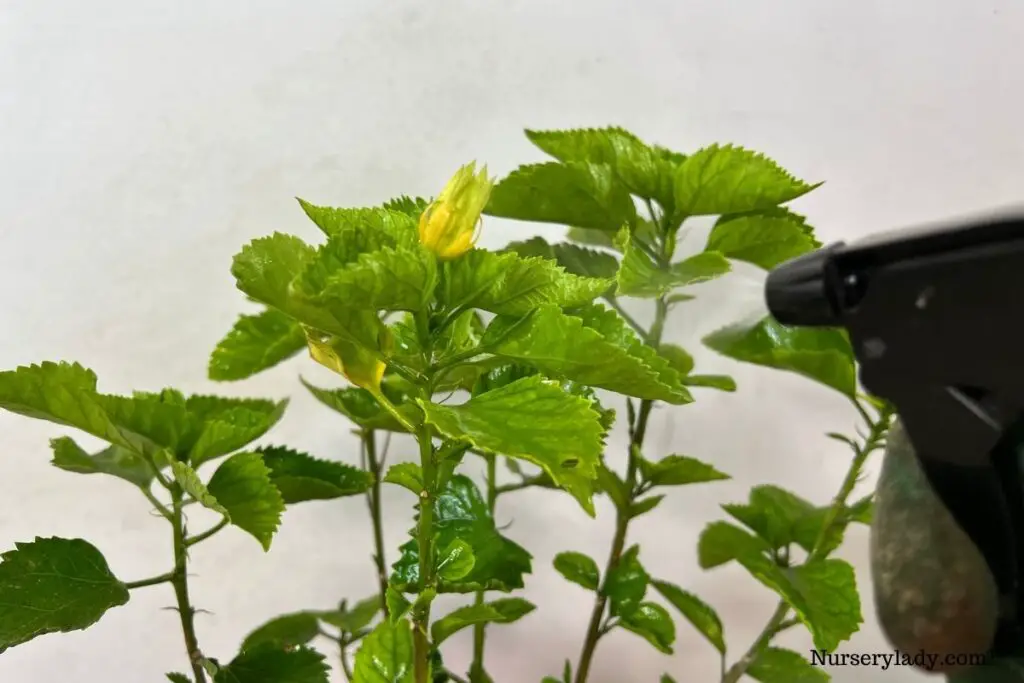
Hibiscus plants are tropical plants, and so they like high humidity ranging between 50% and 70%.
The humidity should not drop below 50%.
Otherwise, the dry air will make the plant dry faster and dehydrated.
To increase humidity, you can try several methods like:
- Installing misting system
- Keep water trays around the Hibiscus plants
- Mulching the soil bed with compost
- Keeping pebble trays under the potted Hibiscus
- Humidifier for indoor Hibiscus
Some greenhouses maintain above 90% humidity level.
But don’t maintain this in your house.
The greenhouse Hibiscus remains under special care.
Let it stay up to 60-70% in your garden or home.
Also read: Do Hibiscus Like To Be Misted? (+Humidity Requirements)
7. Transplant Hibiscus and rejuvenate the soil every year.
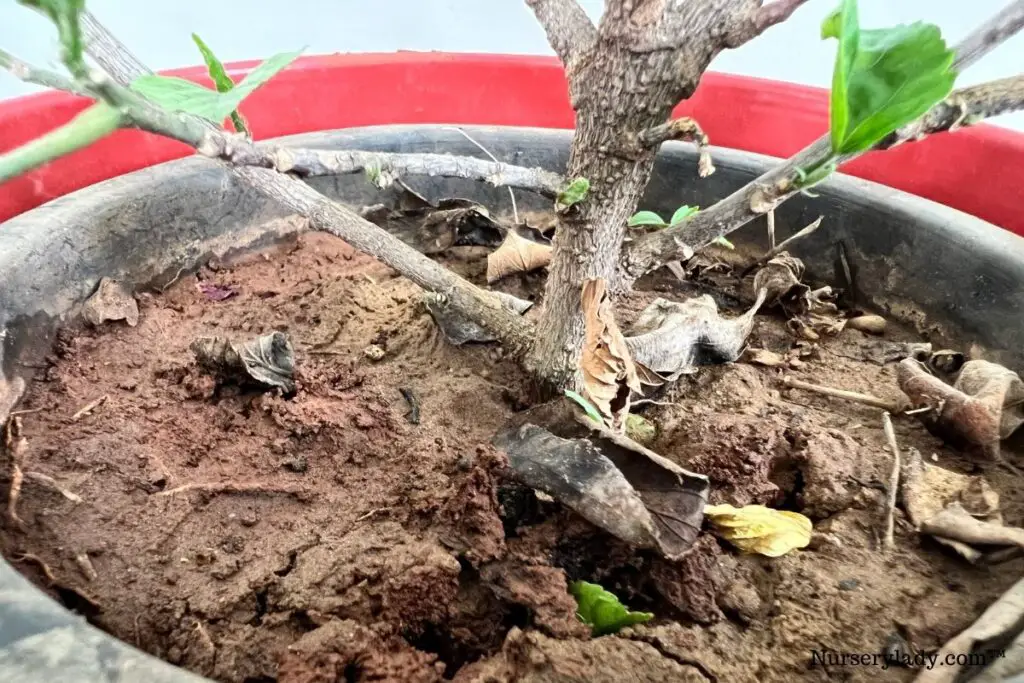
Hibiscus plants are quite fast-growing.
They can reach about 10-15 feet within 2-3 years.
So, repot them to a 1-2 inches bigger pot every year.
It will give them more space to develop and spread without any obstacles.
Repotting the Hibiscus plant with new soil allows the plant to get fresh nutrients from the soil.
The old soil gets depleted over time and lacks nutrition.
If you are not using a pot, you don’t have to transplant Hibiscus plants for space because their growing space is not limited like that of pots.
Rejuvenate the top 6-8 inches of the soil and add fresh ingredients to make the soil more fertile.
Suppose your plant has any boundaries around it, like walls or pipes.
In that case, you might have to transplant your plant to some other location without such barriers.
Also read: Will My Hibiscus Plant Come Back?
8. Prune Hibiscus to encourage new stems, flowering, and a bushy plant.
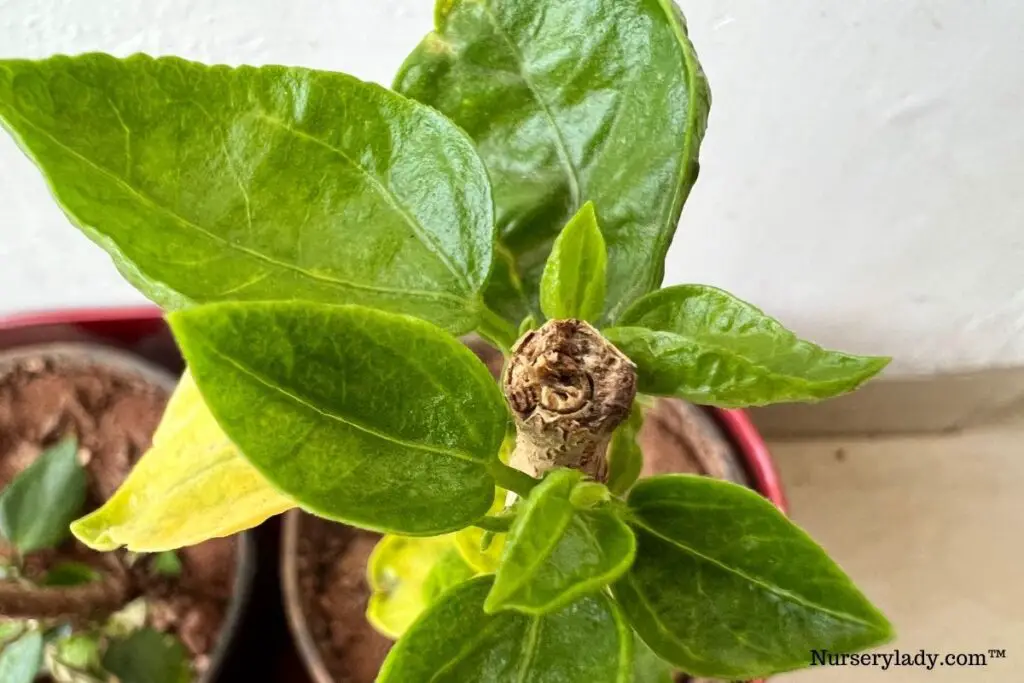
The Hibiscus pruning techniques are selective, corrective, pinching, full, and hard.
In selective pruning, remove the branches in the odd directions.
In corrective pruning, prune the misshapen, dead, and damaged stems.
Full and hard pruning includes removing maximum branches to encourage more stem development than before.
It helps the plant to become bushy and full of flowers.
Never prune more than 30-50%.
Always trim the branches 1/4th below or above the leaf node.
Leave 2-3 nodes from the top and prune above the 4th node during full pruning.
Leave 2-3 nodes in each branch in hard pruning and prune the rest above.
Also read: How To Prune Hibiscus? (A Step-By-Step Guide)
9. Propagate Hibiscus to get more plants.
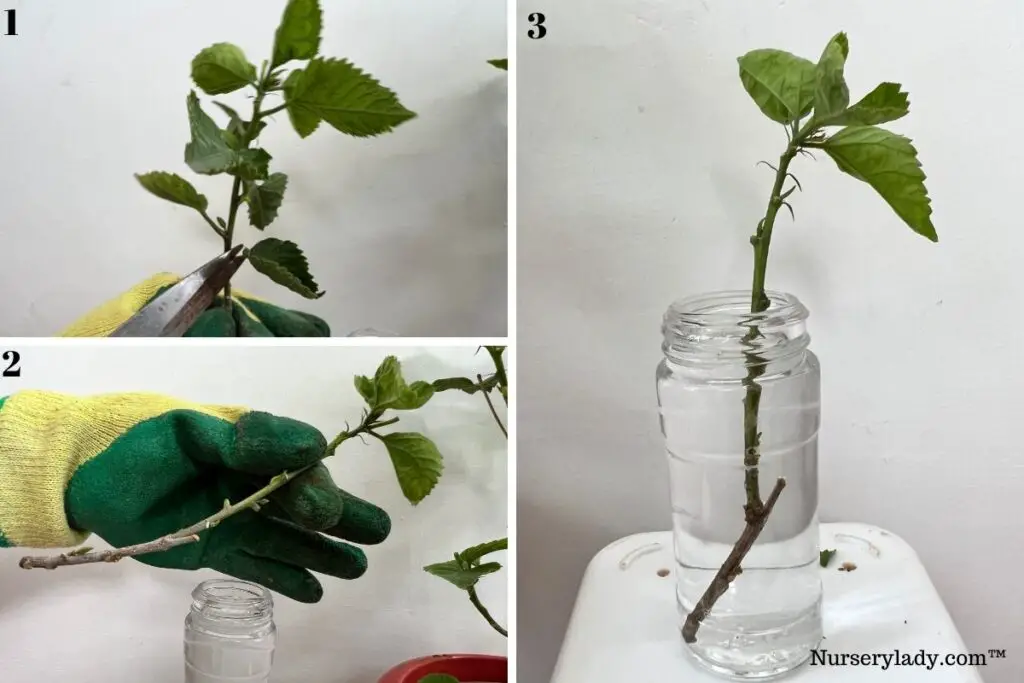
If you want more Hibiscus plants without buying, propagate.
Hibiscus plants are propagated more often by stem cuttings and seeds.
Find some healthy stems, and cut diagonally around 6-8 inches at the ¼th inch above the leaf node.
Expose the cambium layer at the bottom of the stem around 1-2 inches at 1-2 sides, dip the ending into rooting hormone and plant it in the ideal soil mix.
You can also dip the stems into water.
Transplant them once the new roots become tanned.
Collect the seeds from the seedpods and rough them a bit with sandpaper.
Soak them in water overnight or wrap them in a damp cloth.
Fill up a pot with ideal soil mix, plant the seeds 1/4th inch deeper, and moisten the soil.
It will take 2-4 weeks to sprout.
Harden the seedlings and transplant them to an ideal location.
Another method is air layering. Mark a stem’s bark at two places keeping a 1-inch distance.
Remove the outer and cambium layers to expose the white layer at the center of those two points.
Brush some rooting hormone and add a handful of sphagnum moss to the place.
Cover it with plastic and tie it to the two ends to seal.
Cover it again with aluminum foil and then brown paper.
Check the rooting after 4-5 weeks.
Cut the branch when there are sufficient root growths.
Transplant it into a new pot with the ideal soil mix.
Please don’t remove the sphagnum moss now, as the roots will remain entangled with it.
Also read: How To Propagate Hibiscus? (4 Methods+Step-By-Step Guide)
10. Get the right pot for a healthy Hibiscus plant.
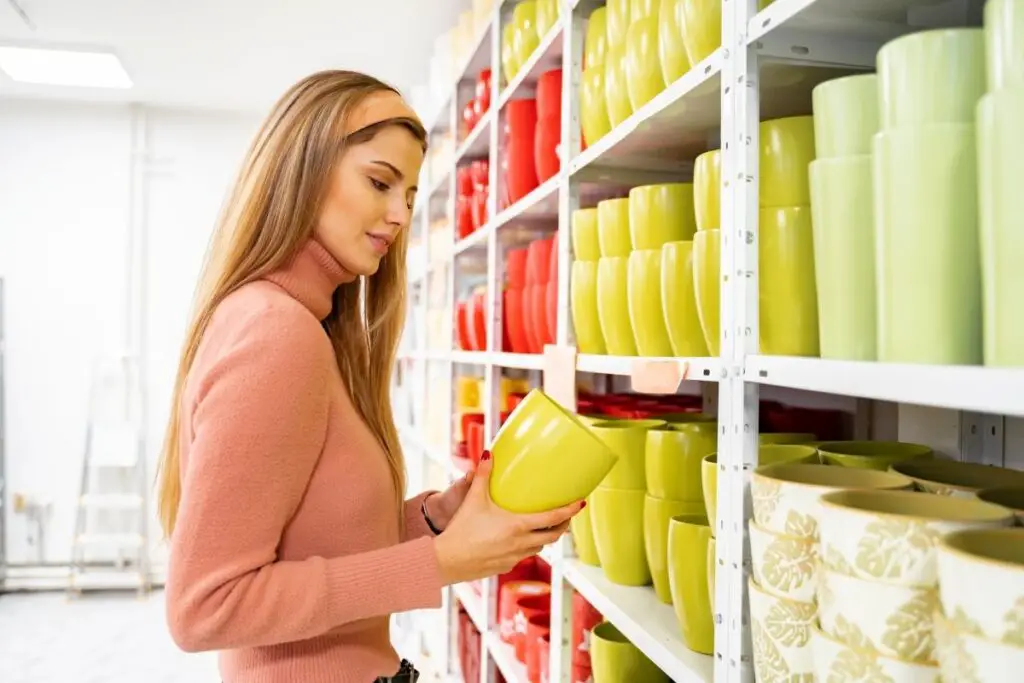
You can use any pot of your choice, but for Hibiscus, terracotta, ceramic, wood, and plastic are best.
Terracotta and wooden pots are porous pots.
Suppose you ever overwater or use heavy soil mixes without knowledge.
In that case, these pots can save your plant from getting waterlogged and help in the draining process.
You can also use glazed or plastic pots.
These pots will hold moisture for a little longer and prevent the plant from facing dry conditions.
The pot size should be proportionate to the plant size and 1-inch bigger than the root ball.
Since Hibiscus plants are fast-growers, a little big pot won’t let the plant suffer root-bound easily.
Use a pot 1-2 inches bigger than the old one for repotting.
Cut 1/3rd of your plant and put it in the same pot if you don’t want it to grow big.
Also read: What Kind Of Pot Is Best For Hibiscus? (Size, Material & More)
11. Keep your pets away from Hibiscus roots, as these are toxic.
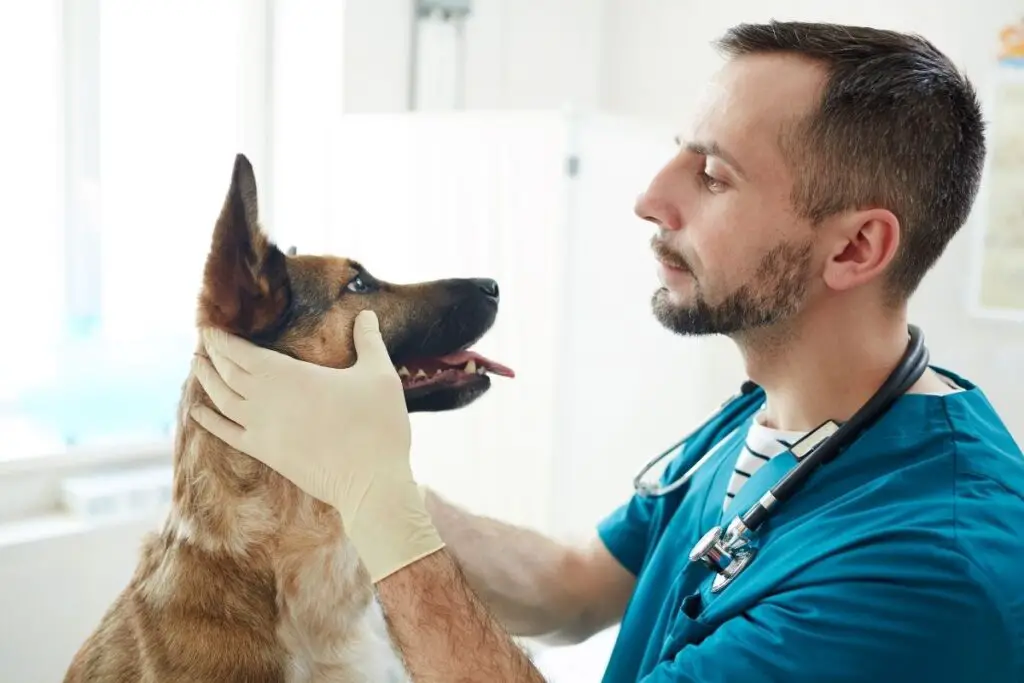
Hibiscus plants are declared non-toxic to pets like dogs, cats, and other small animals.
Hibiscus flowers can increase their overall health because the flowers are loaded with vitamin C and antioxidants.
Since Hibiscus is rich in fiber, excessive absorption will result in diarrhea.
Some pets are sensitive to high-fiber diets.
Animals like chinchillas and hamsters are fed with dried Hibiscus flowers to improve digestion and energy.
The roots of the Hibiscus plants are the most poisonous to all the animals.
So, keep the pet animals away from these plants.
A variety named Rose of Sharon is also poisonous.
It contains an amino acid named Asparagine which is harmful.
Though Hibiscus is safe, pets should not consume it in huge amounts, especially the roots.
It will cause vomiting, loss of appetite, throat burning, diarrhea, corneal damage, etc.
Also read: Are Hibiscus Poisonous To Pets? (Cats, Dogs & Other Animals)
Final thoughts
Hibiscus plants are easy to grow. Your Hibiscus plant will reward you with colorful blooms if you give them sufficient attention and fulfill their basic needs.
You should also be familiar with the troubles that Hibiscus faces. Prepare yourself to fix the issues in time rather than quitting. Take preventive measures instead to help your plant fight the challenges.
Your plant will rarely face any issues by following these shared care tips.
Reference: Wikipedia, ASPCA, Louisiana State University Agricultural Center, American Society for Horticultural Science, Tropical Hibiscus by Texas A&M University, Sciencedirect.
